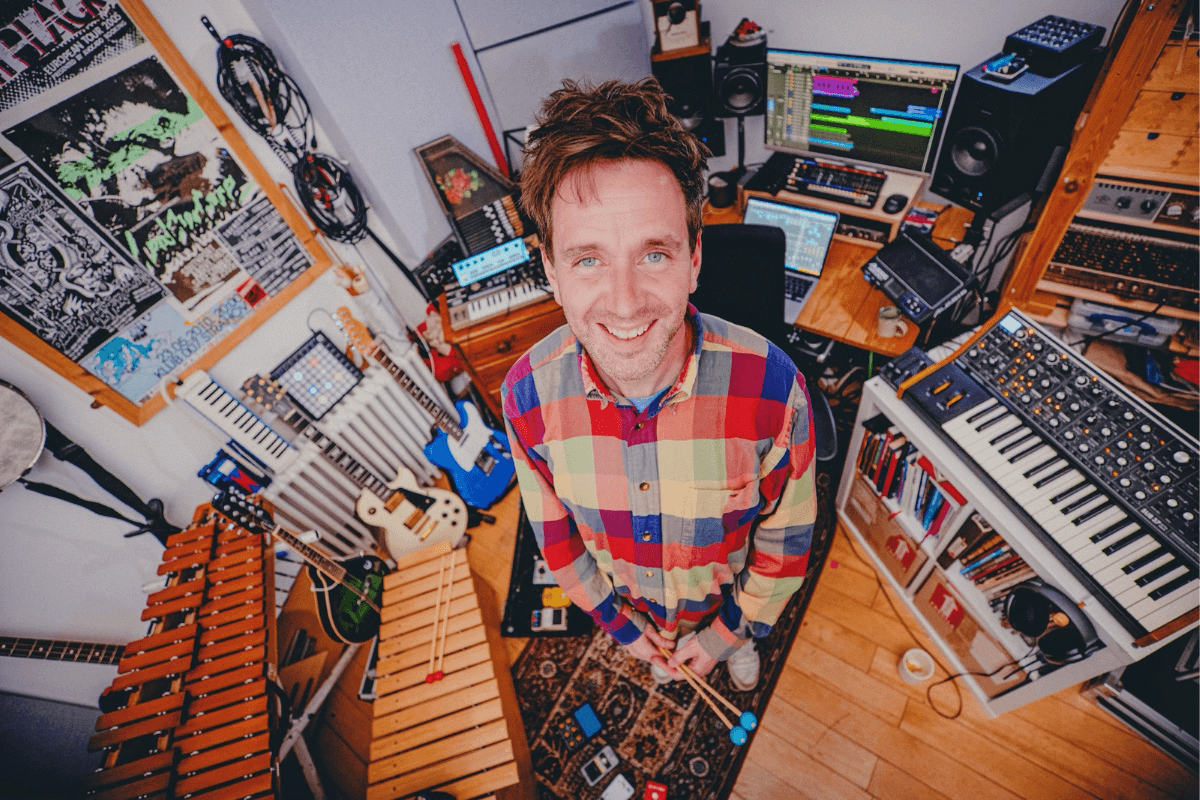It was March 2023 when Paul Russell first realised that something was wrong. “I started noticing sounds being quite uncomfortable,” says the Glasgow-based composer, producer and multi-instrumentalist.
“It started with the kids at home. Then I noticed it on trains or at the airport, the Tannoy systems or the beeping noise when the doors open. I do quite a lot of work as a front-of-house sound engineer. When I went to mix a concert, the drummer started playing the kick drum and it pinned me to the back of the wall. It was just completely impossible for me to be around that level of volume.”
Hyperacusis, a condition that results in a reduced tolerance to sound.
Paul sought help from an ENT specialist, who diagnosed hyperacusis, a condition that results in a reduced tolerance to sound. People with hyperacusis often find ordinary noises too loud and experience discomfort and pain.
One of the most common causes is exposure to loud noise, so by the nature of their work, musicians are more susceptible. For those experiencing symptoms for the first time, it can be an alarming experience.
“It was absolutely terrifying,” says Paul. “I also had quite an unhelpful ENT appointment, where the consultant did some tests then told me that I have irreparable hearing loss that is caused by me being in loud environments, and that it's my fault, it'll last forever and there's nothing I can do about it. I play quite a lot of tuned percussion instruments, so with things like xylophones and marimbas I was finding the attack of the mallet quite distressing on my ears. Some of the lowest points were when I felt like I'm not sure if I can play music again.”
The adverse impact on mental health
Hyperacusis can also have an adverse psychological impact. Paul found that his usual “positive, sunny demeanour” gave way to anxiety and he began to experience an acute tightness in his chest.
Such psychological concerns are echoed by ‘Aiden’ [real name withheld at the musician’s request], who believes that years of gigging and “inept monitor engineers” contributed to hyperacusis, although he says the damage was directly caused by “screaming teenage fans” standing right behind him at a gig he attended in late 2019.
“I've lost some top-end hearing thanks to it all… the worst aspect of it all is being advised not to gig until things improve and my anxiety over the thought of playing again settles. It's truly demoralising going through this for a second year. I miss the social camaraderie of gigging. My favourite nights out were always playing music with people, who were usually either mates or who had become good friends through the bonding that [comes from] performing with others. I really do miss that.”
 Paul Russell in his studio: “The idea is that by going through the sound therapy, your brain reprogrammes your volume levels.” Image credit: John Cook Lynch.
Paul Russell in his studio: “The idea is that by going through the sound therapy, your brain reprogrammes your volume levels.” Image credit: John Cook Lynch.
The most common cause of hyperacusis
As Clinical Director of Musicians’ Hearing Services, Dr Paul Checkley is all too aware of the implications of hyperacusis. He says the condition is “fairly common” in his audiological practice, although the incidence in the general population is estimated at around nine per cent. The most common cause of hyperacusis among musicians, he says, is damage to the inner ear resulting from overexposure to loud music.
Hyperacusis is often accompanied by tinnitus
“Many people report a particular intolerance to high frequency sounds, but it can be any sound. Obviously, hyperacusis can affect all areas of life and in turn the general well being of the individual. Some people feel tense around certain sounds and can even feel angry and desperate to remove themselves from the sound. I saw one musician in clinic who had real difficulty with the crying of his small child, which was extremely upsetting for him as a father.”
Anxiety and depression are not an inevitable result of reduced tolerance to sound, says Checkley, but they can be linked. An individual's ability to tolerate sound can be affected by tiredness or stress levels, which can in turn serve to increase overall levels of stress and anxiety.
The type of sound does not necessarily make a difference to the level of tolerance, he adds, and the fact that music is a “pleasant” sound does not mean that this will be more easily tolerated. “I have seen musicians and DJs in clinic who are not able to work because of their hyperacusis and this is obviously very concerning for them.”
Hyperacusis is often accompanied by tinnitus, says Checkley, as well as other hearing conditions and “perhaps some related psychological issues”. The challenge for audiologists is determining which condition is causing the most profound symptoms.
“It is not possible to say which condition is more concerning and it can be difficult to separate these conditions when the individual has several different but related difficulties. Each person is treated as an individual and their treatment options are tailored to their specific needs.”
Why prevention is key
The most effective way to avoid hyperacusis is to prevent hearing becoming damaged in the first place. Noise-induced hearing loss is 100% irreversible but 100% preventable, so wearing hearing protection and getting specialist advice is vital.
Noise-induced hearing loss is 100% irreversible but 100% preventable
The MU’s partner Help Musicians can provide heavily discounted audiological assessments and Musicians’ Hearing Services (MHS) is another valuable service, with permanent clinics in London, Manchester and Aberdeen, and a rolling programme of regular clinics in Belfast, Birmingham, Bristol, Cardiff, Edinburgh, Exeter, Glasgow, Leeds, Newcastle, Norwich, Nottingham, Sheffield and Southampton.
How to treat hyperacusis
For those diagnosed with hyperacusis, there is treatment that can help minimise or even eradicate symptoms.
After being told by his ENT consultant in Glasgow that his condition was irreparable, Paul Russell sought a second opinion from Musicians’ Hearing Services. He was given a course of cognitive behavioural therapy (CBT), which helped him cope with the anxiety that hyperacusis caused.
For the physical symptoms meanwhile, he was prescribed a course of treatment with ‘sound generators’, fitted ear devices that play white noise or pink noise to help the brain lower its strained super-hearing, that is associated with the stress from hyperacusis.
Sound therapy is essentially ear rehabilitation and requires at least two hours treatment a day. It also requires self-motivation, patience and time, and the reassurance from audiologists that the noise being introduced will not harm the hyperacusis patient.
“The idea is that by going through the sound therapy, your brain reprogrammes your volume levels,” says Paul Russell. “I’ve been wearing them since August, and only take them off when I go to sleep. I would wear them for a month and then the audiologist would say ‘how are you feeling?’ I would say ‘I’m feeling fine’ and they would say ‘Okay, let’s turn them up one and see how you are then’. So the idea is to gradually get your brain used to it.”
Aiden has also been treated with sound therapy but so far, the results are mixed. “I've become more used to calling them hearing aids, with low level white noise being generated to hopefully reverse the sensitivity. Sometimes I wear them all my waking hours. Other days, I resent these alien objects and glare at them dismissively until I relent and pop them in.”
 Paul Russell with his orchestral ensemble Human Pyramids. Image credit: John Cook Lynch.
Paul Russell with his orchestral ensemble Human Pyramids. Image credit: John Cook Lynch.
Working with a therapist
Dr Paul Checkley says the therapist will work with the individual to introduce sounds and attempt to slowly build tolerance. “The therapist will devise a personalised treatment plan depending on the individual needs of each person. There is not a ‘one size fits all’ solution to this issue.”
If you honestly think that extreme sound levels won't damage your ears, think again. It's not worth risking it.
For Paul Russell, the sound therapy treatment along with the cognitive behavioural therapy he received at Musicians’ Hearing Services have been “life-changing”. His audiologist has now introduced a programme of listening to music, starting with half an hour each day and building up in half hour increments. Russell always wears hearing protection when playing live but is wary about mixing live sound as that is what caused his problems in the first place.
“I'm totally rehabilitated in terms of listening to sound but it’s not to say it couldn't flare up again in the future. I'm currently mixing my own record, which I'm using as a sort of rehabilitation project. But I think I’ve still got a journey to go on.”
For Aiden, meanwhile, the symptoms of hyperacusis are still having a significantly adverse impact on his life. He has suffered from the condition for three-and-a-half years and urges anyone exposed to loud music to wear hearing protection. “I'll always regret not wearing ear plugs at that gig in late 2019. I’m not too sure [if it would have] totally saved me, but it may have extricated me from this weird disorder that makes the noise of overground train doors about to close cut right through me. If you honestly think that extreme sound levels won't damage your ears, think again. It's not worth risking it.”
Where To Get Help
The MU, Help Musicians and Musicians’ Hearing Services are committed to raising awareness of hearing conditions. The three organisations created the Musicians Hearing Health Scheme, which aims to provide all professional musicians in the UK with access to specialist hearing assessments and protection.
View advice on hearing and the discounts offered to MU members through the Musicians’ Hearing Health Scheme below.
Learn more